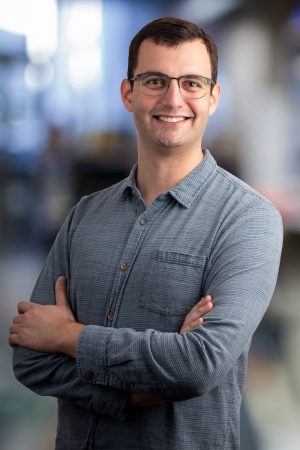
November 30, 2023
LA JOLLA—The Salk Institute has appointed Adam Bowman to the Salk Fellows Program, where he will join current Salk Fellow Talmo Pereira. Joining in March 2024, Bowman is an applied physicist who develops new technologies for optical microscopy.
The Salk Fellows Program brings scientists from broad disciplines to the Institute to encourage innovation and perpetuate the Institute’s collaborative spirit. Most fellows come directly from a PhD or MD program and have expertise in a wide range of innovative technologies—like Bowman, who recently completed his PhD at Stanford University.
During his graduate thesis work, Bowman developed a new fluorescence lifetime microscopy technique from concept through multiple refining iterations. He will bring this technique to Salk, where he will collaborate with other Salk faculty to apply the technique in new biological contexts and across model systems.

“Adam’s creative and interdisciplinary scientific goals will be a powerful addition to the Fellows Program,” says Salk President Gerald Joyce. “His innovative approach to time-resolved microscopy at high resolution will help push the boundaries of cell and organismal biology and will foster productive collaborations with our esteemed faculty in neuroscience and other disciplines.”
Bowman looks at the ways cells communicate across both space and time. This cellular communication is mediated by a complex array of messengers including ions, small molecules, and membrane potentials. Measuring those signals at a microscopic scale is critically important to understanding their role in brain function and characterizing their disruption in disease. However, accurate measurements are difficult to gather in biological environments because most methods disturb the cells or tissues being studied and do not capture spatial context.
To address this difficulty, Bowman develops microscopy techniques to study signaling in live cells and tissues. While most microscopes operate on the timescales of life (milliseconds to hours), they miss the faster dynamics of fluorescent probe molecules, such as the nanosecond excited state lifetime (the short amount of time that a molecule can exist in a higher energy excited state). Bowman uses fluorescence lifetime and nanosecond optical methods to improve scientists’ ability to visualize live cell communication. At Salk, he will continue to refine and innovate to create more effective imaging and measurement techniques.
“I am a tinkerer at heart and am motivated to build new technologies that can improve biological measurements. I was lucky to work in an amazing environment for my PhD where I was able to develop this technique from scratch towards a widely-deployable tool,” says Bowman. “I want to keep building out related methods and I cannot think of a better place to do that than Salk. I’ll be surrounded by world-class biology and have the opportunity to collaborate across disciplines and work in models only possible here. Neuroscience, plant biology, computational biology, worms, fruit flies, and mammals—Salk has it all.”
Bowman has earned numerous awards and honors, such as the PicoQuant Young Investigator Award, a Stanford Graduate Fellowship, a National Science Foundation Graduate Research Fellowship, and the Kusaka Memorial Prize in Physics from Princeton University.
Office of Communications
Tel: (858) 453-4100
press@salk.edu
Unlocking the secrets of life itself is the driving force behind the Salk Institute. Our team of world-class, award-winning scientists pushes the boundaries of knowledge in areas such as neuroscience, cancer research, aging, immunobiology, plant biology, computational biology and more. Founded by Jonas Salk, developer of the first safe and effective polio vaccine, the Institute is an independent, nonprofit research organization and architectural landmark: small by choice, intimate by nature, and fearless in the face of any challenge.